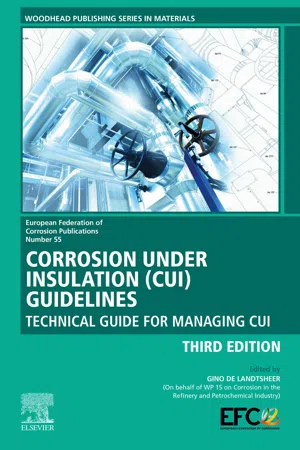
Corrosion Under Insulation (CUI) Guidelines
Technical Guide for Managing CUI
- 180 pages
- English
- ePUB (mobile friendly)
- Available on iOS & Android
About this book
Corrosion Under Insulation (CUI) Guidelines: Technical Guide for Managing CUI, Third Edition, Volume 55 builds upon the success of the first two editions to provide a fully up-to-date, practical source of information on how to monitor and manage insulated systems. In the first edition of this book published in 2008, the EFC Working Parties WP13 and WP15 engaged together to provide guidelines on managing CUI with contributions from a number of European refining, petrochemical, and offshore companies. The guidelines were intended for use on all plants and installations that contain insulated vessels, piping, and equipment, and cover a risk-based inspection methodology for CUI, inspection techniques, and recommended best practices for mitigating CUI.The guidelines include design of plant and equipment, coatings and the use of thermal spray techniques, types of insulation, cladding/jacketing materials, and protection guards. Corrosion-under-insulation (CUI) refers to the external corrosion of piping and vessels that occurs underneath externally clad/jacketed insulation as a result of the penetration of water. By its very nature CUI tends to remain undetected until the insulation and cladding/jacketing is removed to allow inspection, or when leaks occur. CUI is a common problem shared by the refining, petrochemical, power, industrial, onshore and offshore industries.- Provides revised and updated technical guidance on managing CUI provided by EFC Working Parties 13 and 15- Discusses the standard approach to risk based inspection methodology- Presents the argument that CUI is everywhere, and looks at mitigating actions that can be started from the onset- Includes a wide array of concepts of corrosion mitigation
Frequently asked questions
- Essential is ideal for learners and professionals who enjoy exploring a wide range of subjects. Access the Essential Library with 800,000+ trusted titles and best-sellers across business, personal growth, and the humanities. Includes unlimited reading time and Standard Read Aloud voice.
- Complete: Perfect for advanced learners and researchers needing full, unrestricted access. Unlock 1.4M+ books across hundreds of subjects, including academic and specialized titles. The Complete Plan also includes advanced features like Premium Read Aloud and Research Assistant.
Please note we cannot support devices running on iOS 13 and Android 7 or earlier. Learn more about using the app.
Information
1: Introduction
Abstract
Keywords
- ● Water or moisture must be present on the substrate, in order to allow oxygen corrosion to occur. Water ingress is due to breaks in the insulation, cladding or jacketing which may have resulted as a consequence of poor installation or damage during service or simply be a result of deterioration over time. The principal sources of water are as follows:
- o External sources which include rainwater, deluge systems and process liquid spillage.
- o Condensation.
This water may be retained depending on the absorption properties of the insulation material and the operating temperature. Depending upon process conditions, saturated insulation may never have the opportunity to dry out completely.
Table of contents
- Cover image
- Title page
- Table of Contents
- Copyright
- Dedication
- European Federation of Corrosion (EFC) publications: Series introduction
- Volumes in the EFC series list
- 1: Introduction
- 2: Economic consideration
- 3: Ownership and responsibility
- 4: The risk-based inspection methodology for CUI
- 5: Inspection activities and strategy
- 6: Non-destructive examination and testing screening techniques for corrosion-under-insulation
- 7: Recommended best practice to mitigate CUI
- 8: Design for the prevention of corrosion-under-insulation
- Appendix A: Cost-economic evaluation
- Appendix B: Quality assurance
- Appendix C: Additional guidelines on the implementation of CUI best practices
- Appendix D: Coatings
- Appendix E: Application of thermally sprayed aluminum
- Appendix F: Types and forms of insulation material
- Appendix G: Cladding and jacketing materials
- Appendix H: Use of protection guards
- Appendix I: Non-destructive examination and testing techniques
- Appendix J: Case studies
- Index